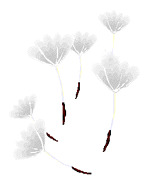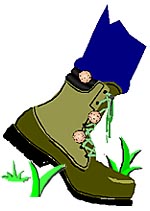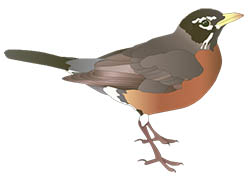How Do Seeds Travel?
Plants may not be able to move from place to place, but seeds can. Here are some ways that seeds get around:

Seeds with wings - Some seeds have parachutes or wings like a glider. The wings and parachutes slow them down as they fall from the mother plant. Then the seeds are carried away from the mother by air currents. The dandelion seeds in this drawing are a great example.

Hitchhikers - Have you ever gotten home from a field trip and found your socks covered with sticky or prickly seeds? These seeds are now in a new place because you carried them. Animal fur and feathers are also good places to stick to and catch a ride.

Going with the flow - The seeds of some plants that live in the water, or close to it, can float. A good example is the coconut. A coconut falls from its mother plant onto the beach. When the tide comes up or there's a swell, the ocean picks up the floating seed. Ocean currents then take the seed to another beach, where it can grow into a coconut palm tree.

Some seeds need a little help from animals. They have to be eaten first to get started. It might not seem like a great way to start life, but they end up in a pile of natural fertilizer to get a jump on germination. Robins are a good example of a seed disperser. They eat the seeds of Poison Oak and Poison Ivy and later deposit them in a new place to grow. Humans are also seed dispersers. Rasberry and Blueberry seeds have for a longtime been carried and planted after person dines on these sweet fruits.
American Robin Illustration: Tracey Saxby, Integration and Application Network, University of Maryland Center for Environmental Science (ian.umces.edu/imagelibrary/)
Read more about: Time Traveling Plants
Bibliographic details:
- Article: How Do Seeds Travel?
- Author(s): Dr. Biology
- Publisher: Arizona State University School of Life Sciences Ask A Biologist
- Site name: ASU - Ask A Biologist
- Date published:
- Date accessed:
- Link: https://askabiologist.asu.edu/content/how-do-seeds-travel
APA Style
Dr. Biology. (). How Do Seeds Travel?. ASU - Ask A Biologist. Retrieved from https://askabiologist.asu.edu/content/how-do-seeds-travel
Chicago Manual of Style
Dr. Biology. "How Do Seeds Travel?". ASU - Ask A Biologist. . https://askabiologist.asu.edu/content/how-do-seeds-travel
Dr. Biology. "How Do Seeds Travel?". ASU - Ask A Biologist. . ASU - Ask A Biologist, Web. https://askabiologist.asu.edu/content/how-do-seeds-travel
MLA 2017 Style

A few remaining dandelion seeds wait to be carried by the wind to the place where they can germinate and grow into a new plant.
Be Part of
Ask A Biologist
By volunteering, or simply sending us feedback on the site. Scientists, teachers, writers, illustrators, and translators are all important to the program. If you are interested in helping with the website we have a Volunteers page to get the process started.

